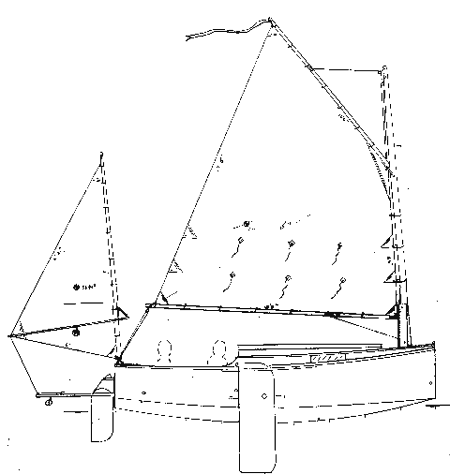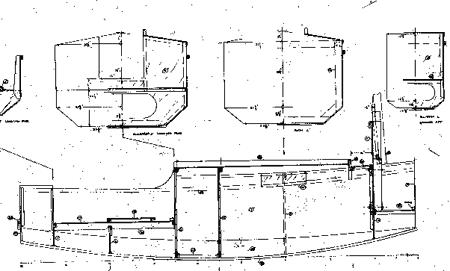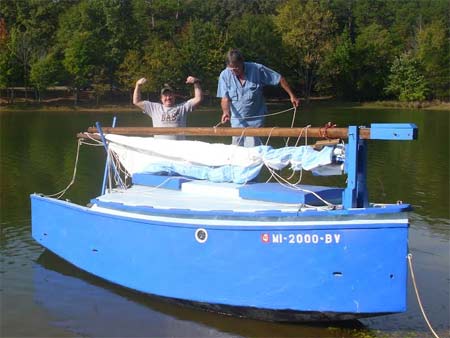CABIN SAILBOAT, 18' X 6", 1300 POUNDS EMPTY
A while back I presented a design called Fatcat2 which was a 15' x 6' unballasted sailing cuddy catboat. It is still in the prototype catalog, although one was built a few years ago but never used to my knowledge. A problem with any unballasted boat is that if it capsizes it will usually lie on its side and the skipper will need to go for a swim to right the boat and then he has the problem of getting back into the righted boat.
The usual fix for that problem is to deck the boat over very well so that nothing will flood when the boat gets knocked down by the wind. (I'm reminded of Reed Smith's Rule that any boat that gets sailed a lot will eventually get knocked down.) Then ballast is added down low such that the boat's center of gravity will be "below" the boat's center of buoyancy when it is on its side. The lower the ballast, as on the end of a deep fin or keel, the less ballast is needed but of course the draft of the boat goes way up. Buoyancy up high, such as a high raised deck, also helps but there are limits to that too since the boat's CG will also be raised with it, both because of more structure up high and also because the crew weight, which often is a major contributor to a high CG, must be lifted higher so that the skipper can still see ahead over the new raised deck.

So Picara is in a lot of ways a Fatcat2 that has gone through the above changes to make it self righting, that is to say if knocked over it will right itself when the wind force is eased, with the crew staying on the deck, shedding water like a duck and being ready to go again once the crew feels up to it. (Even here the idea of "self righting" means different things to different sailors. Howard Chapelle wrote somewhere that a sharpie is selfrighting if it can return from 45 degrees of heel. I'm quite certain that is not enough for most of us. Blue water sailors try to self right from 140 degrees of heel. No, the wind won't blow you over that far but a big wave can roll you that far. On my ballasted boats, like Picara, I try to get the boat to self right from 90 degrees, a compromise I suppose, but I don't design blue water boats.)
To get Picara to right from 90 degrees with two adults sitting on the aft deck requires 500 pounds of steel ballast spread flat on the deepest part of the boat's bottom in addition to using a 1" thick plywood bottom which also has about 100 pounds of ballast effect. Sound like a lot? Maybe so but the numbers kept coming up the same using Hullforms6 to figure the hydro work. I believe it. I tried it with water ballast but gave up. Steel is over eight times as dense as water so the 1-1/2" steel plate I show as ballast would be equal to a water tank over 12" deep to match the weight, but with internal ballast the water would end up centered about 6" above the bottom where the steel sits centered .75" above the bottom so the water ballast was no where near as effective here as steel. It won't work here.

Picara is 18' long where Fatcat2 was 15' in order to get a cabin that two people might really sleep in. There is a small anchor well ahead of the cabin, a raised deck aft of it, and a motor well in the stern. I used multichines to get a hull that can handle rough water better than a flattie. That makes it a taped seam project. She needs nine sheets of 1/4" plywood, six sheets of 3/8" plywood, and seven sheets of 1/2" plywood. The resulting pile of plywood would weigh about 800 pounds and I would expect the empty hull to weigh about that. Add 500 pounds of ballast and you have about 1300 pounds on the trailer. The wide deep hull can handle that and it takes a total weight of 2500 pounds to set it down 10" deep so its chines touch the water.

As for the sail rig, I used a gaff sail to get good area from a short 17' mast which pivots on a tabernacle and stows within the length of the trailered boat. I added a small mizzen for balance and provide steadying at anchor or during sail changes.